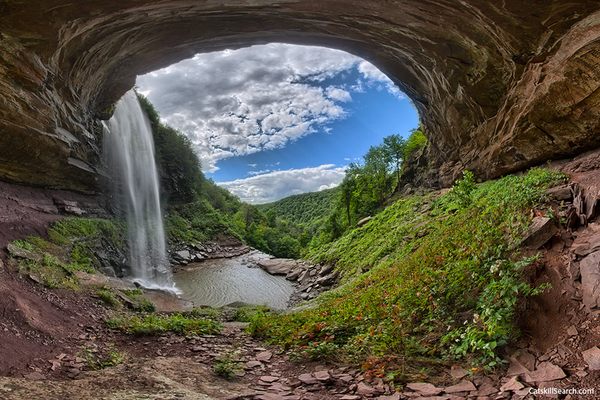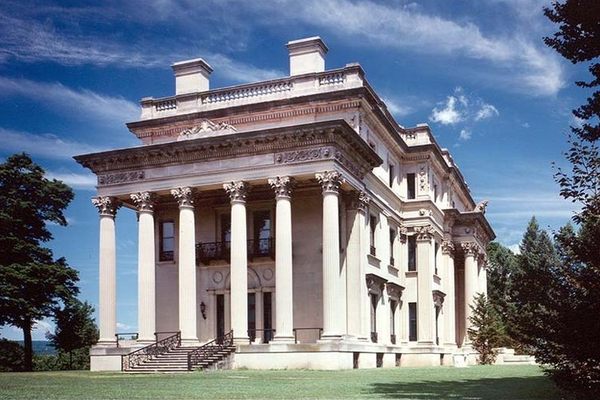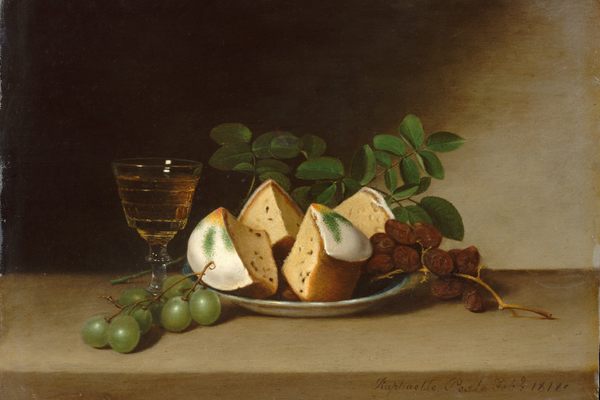The Sublime Beauty of the Hudson River through 19th-Century Eyes
“A View On The Catskill, Early Autumn” Thomas Cole (1837) (via Wikimedia)
Nearly 200 years ago, English-born painter Thomas Cole rode a steamship up New York’s Hudson River on a weekend getaway to the Catskill Mountains. Cole was so struck by the dramatic views and the vivid colors of the river valley’s fall foliage that he got off twice along the way to explore and make sketches for future paintings. Within two years, Cole had moved upstate permanently, and other artists flocked to join him, producing a series of landscapes so rich in detail that modern art scholars can pinpoint exactly where each artist stood as he worked. The Hudson River School Trail, maintained by the Thomas Cole National Historic Site, has marked off several of these spots so visitors can take in the same views.
The trail also honors the first American art movement. In the 1800s, the United States was developing its own identity as a brand-new nation; the cultural elite sought art that celebrated anything distinctly American, and embraced the dramatic landscapes produced by Cole and his compatriots. Art lovers were inspired to visit the spots themselves, seeking out the vast, unspoiled vistas in the works.
Sometimes, though, the wilderness wasn’t unspoiled. One such site is Kaaterskill Clove, a deep gorge just west of Palenville, New York. In the early 1800s, the Clove was filled with hemlock trees, and several tanneries set up shop to take advantage of the access to cheap lumber. In Cole’s time, however, the Clove was already in rapid deforestation. But he put the trees back in his 1827 painting “The Clove,” showing the valley bedecked with a restored fall color.
Thomas Cole, “The Clove” (1827) (via Wikimedia)
Cole’s work helped an early environmental push to protect the Hudson Valley. Today, plenty of trees have grown back in the Clove, so contemporary visitors can witness the same beauty as in Cole’s painting.
Kaaterskill Clove (photograph by Colin D. Young)
Near Kaaterskill Clove is the breathtaking Kaaterskill Falls. The two-tier waterfall became a tourist must-see in the 1800s, immortalized not only by Hudson River School painters, but also by writers like James Fenimore Cooper and Washington Irving, whose Rip Van Winkle encounters the Falls after his long sleep. It was Irving’s mention of the Falls in his story which inspired Thomas Cole to seek them out.
Thomas Cole, “Falls Of The Kaaterskill” (1826) (via Wikimedia)
In the past, a hiking trail went all the way behind the cascade; the trail now ends at the base of the Falls.
Kaaterskill Falls (photograph by Colin D. Young)
Cole’s painting of the view from Sunset Rock, another peak near Tannersville, includes a building absent today — the demolished Catskill Mountain House Hotel. The Catskill Mountain House enjoyed several decades as New York’s finest Catskills hotel; however, part of its popularity came from the belief that it sat on the tallest mountain in the region. Then in 1880, a visiting surveyor discovered another mountain to the southwest was actually taller. Business at the Catskill Mountain House dried up. It closed in 1941, and was torn down in the 1960s. Still, the rest of Cole’s view from Sunset Rock is largely unchanged — and as spectacular as ever.
Thomas Cole, “Catskill Mountain House, The Four Elements” (1843-44) (via Wikimedia)
Sunset Rock (photograph by Colin D. Young)
A bit further south, visitors can find three trail stops on the grounds of the Mohonk House, another mountain resort established in 1869. Its founders also purchased 280 acres of the surrounding valley, and the current owners open the grounds to hikers (with the purchase of a grounds pass). The lake and the surrounding Shawnagunk Mountains were luring visitors long before that, including painter Sanford Robinson Gifford, a Hudson Valley-born painter who frequented the ten-room inn which preceded Mohonk House. His view of the Shawnagunk range from the “Sky Top” trail is almost unchanged.
Sanford Robinson Gifford, “From The Shawnagunk Mountains” (1823-1880) (via Wikimedia)
Current view (photograph by Colin D. Young)
The view of “Artists’ Rock,” however, is now a bit different. Granted, this work by Worthington Whittredge wasn’t entirely accurate — he added three woodsmen around a campfire in his “Twilight in the Shawnagunks,” and depicted the rock as much bigger than it is in real life.
Worthington Whittredge, “Twilight In The Shawnagunks” (via artcyclopedia.com)
Today, visitors will find a gazebo built upon the rock, but the view of Eagle Cliff in the distance remains.
Mohonk Artist’s Rock Gazebo (photograph by Colin D. Young)
Mohonk Lake features in a number of Hudson River School works as well, such as this 1858 painting by Scottish-born William Hart:
William Hart, “Lake Among The Hills” (1858) (via Wikimedia)
Whittredge used it as well, and the ubiquitous Thomas Cole also has a work featuring Lake Mohonk. The spot where they all stood is near the present Mohonk House’s dock.
photograph by Colin D. Young
While many of the Hudson River School artists were taken with the mountains and cliffs surrounding the Hudson, Gifford also used the Hudson River. His “Hook Mountain Near Nyack” depicts the river at its widest point, winding past Hook Mountain just north of Croton-on-Hudson.
Sanford Robinson Gifford, “Hook Mountain Near Nyack” (1866) (courtesy Yale University Art Gallery)
This beach view is in Croton Point Park. The exact spot is a bit tricky to find, as it’s only reachable from a side trail near the RV park. But visitors who persevere will find a tiny beach offering the exact view of Hook Mountain which Gifford depicted in 1866.
photograph by the author
Johann Carmiencke was a later member of the Hudson River School. Carmiencke came to New York in 1851, fleeing Germany during a border war with Denmark; the Hudson River reminded him of the German Rhine, and he took to the landscape instantly. This 1859 painting was done on the grounds of Hyde Park, an estate owned by John Jacob Astor’s grandson.
Johann Hermann Carmiencke, “Hyde Park, New York” (1859) (via Brooklyn Museum)
Eventually the property was taken over by the Vanderbilt family, and is now a national historic landmark. An overlook on the grounds preserves Carmeiencke’s view north up the Hudson.
Hyde Park, New York (photograph by the author)
A guide to the complete Hudson River School Trail — which includes nine other Hudson Valley stops, as well as a pair of sites in New Hampshire and Massachusetts and some upcoming sites in Yosemite — can be found here. You can also pick up a booklet about the trail at Cole’s own home in Catskill, New York.
Thomas Cole Historic House, Catskill, New York (photo by the author)

























Follow us on Twitter to get the latest on the world's hidden wonders.
Like us on Facebook to get the latest on the world's hidden wonders.
Follow us on Twitter Like us on Facebook